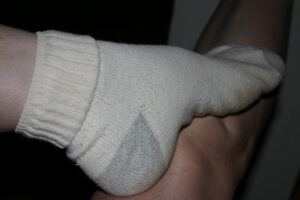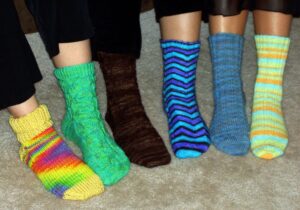For the past few months, I’ve been thinking about socks. I’ve been trying to get synthetics off my skin, and socks were a part of this process for which I couldn’t seem to find a good answer. Buy mass-produced, everyone-buys-them socks from a big-box retailer, and you’ll come home with a sock that’s probably about 50 to 70 percent cotton, 20 to 40 percent polyester, and the remainder spandex, or spandex and nylon.
 I learned a few months ago that polyester is made with propylene glycol, aggravating my propylene glycol allergy, and spandex/lycra/elastane is made with polyester, so that’s more of the same allergy issues there. I also recently learned that isothiazolinones are used in the manufacturing process for nylon, directly coming into contact with the fibre in the lubricating oil that allows the fibre to slide through the machinery better, so nylon isn’t necessarily safe for me either. Yep, I now know I’m additionally allergic to nylon, spandex/lycra/elastane, and polyester, and my allergies haven’t changed at all. All my socks were cotton/polyester/spandex blends, and my feet were becoming dry and rough when not wet, and my skin was sloughing off like mad when I washed my feet. It’s not the first time I’ve had that particular symptom – my entire body did that when I was using body wash with fragrances and isothiazolinones. It wasn’t causing a huge amount of discomfort on my feet, other than itching for about an hour a day, but I knew it was reacting and raising my body’s inflammation levels. Not good.
I learned a few months ago that polyester is made with propylene glycol, aggravating my propylene glycol allergy, and spandex/lycra/elastane is made with polyester, so that’s more of the same allergy issues there. I also recently learned that isothiazolinones are used in the manufacturing process for nylon, directly coming into contact with the fibre in the lubricating oil that allows the fibre to slide through the machinery better, so nylon isn’t necessarily safe for me either. Yep, I now know I’m additionally allergic to nylon, spandex/lycra/elastane, and polyester, and my allergies haven’t changed at all. All my socks were cotton/polyester/spandex blends, and my feet were becoming dry and rough when not wet, and my skin was sloughing off like mad when I washed my feet. It’s not the first time I’ve had that particular symptom – my entire body did that when I was using body wash with fragrances and isothiazolinones. It wasn’t causing a huge amount of discomfort on my feet, other than itching for about an hour a day, but I knew it was reacting and raising my body’s inflammation levels. Not good.
Looking at the options, it seemed I could get either cotton or wool from most places, but even the big-name wool socks were full of spandex and nylon. I do understand the purpose of these fibres. Nylon helps the sock to hold together better, increasing its lifespan, and spandex causes the sock to spring back into shape rather than ending up a giant foot bag. Nevertheless, I needed better.
 What did I learn? First, natural fibre socks aren’t all that cheap. There are two main kinds of natural fibre socks – cotton and wool. Secondly, I learned that 100% natural fibre socks are nearly impossible to find, because of the issues with bagginess and longevity described above. Even ones designed for allergy sufferers are likely to have at least a tiny bit of elastic, well-hidden inside. If I was going to buy socks, I was going to have to compromise a bit, otherwise I would only be able to afford two or three pairs.
What did I learn? First, natural fibre socks aren’t all that cheap. There are two main kinds of natural fibre socks – cotton and wool. Secondly, I learned that 100% natural fibre socks are nearly impossible to find, because of the issues with bagginess and longevity described above. Even ones designed for allergy sufferers are likely to have at least a tiny bit of elastic, well-hidden inside. If I was going to buy socks, I was going to have to compromise a bit, otherwise I would only be able to afford two or three pairs.
- Cotton
Cool, but absorbs sweat and doesn’t release it readily, which can leave you with soggy feet if you’re working out. Does not insulate well, especially when wet.
- Wool
Warm, and absorbs and releases sweat into the air, keeping your feet dry, although it’s also still insulating when wet. Because it breathes so nicely, it’s actually a good fibre for the summer and for workouts. Natural antibacterial action of wool reduces foot odour as well.
- Other
Linen is wicking and cool, and hemp is rougher, though both are hard to find. Rayon (usually from bamboo) is also available, and is technically (from manufacturer standards) considered a natural fibre, but rayon is treated with a lot of chemicals to transform it from solid wood into a ductile fibre, so I try to avoid it. Silk would not be a very durable foot covering.
Here were my top sock picks:
Rawganique [www.rawganique.com] US$9.50 – $24 per pair
Carries products specifically for chemical contact allergy sufferers. They carry socks in organic hemp, linen, and cotton, some with lycra content near the top and some with only two strands of elastic thread. Percentages of other materials are explained, as well as where those materials are used and how to avoid skin contact with them.
ioMerino [www.iomerino.com] US$20 – 25 per pair
Sells socks that are 80% pure Merino wool and 20% nylon, in two heights. If you are not concerned about nylon, these might be a nice choice, though they’re a bit pricey.
Mountain Equipment Co-op (MEC) [www.mec.ca] $9 per pair
The Super-Wool Hiker GX sock is the most affordable low-allergen sock, with 74% Merino wool, though it is still 20% nylon and 6% lycra. To buy the same sock from The Great Canadian Sox Co., their supplier, will cost you $3 more per pair. I did not find any pure natural fibre socks on their website, either. Most of the other brands and socks MEC carries have higher synthetic ratios, and cost a lot more.
Mongrel Tasmanis Socks [www.mongrelsocks.com] AU$5 – 33 per pair
Mongrel sells socks made of cotton, possum, Australian Merino wool, and rayon from bamboo. My top pick is their Pure Wool Mongrel Socks. These socks are made almost entirely of soft, Australian Merino wool, in lots of fun colours. While the website shows that the socks are 100% wool, they do have a toe seam sewn with polyester thread and contain 0.05% cotton-wrapped lycra to help hold their shape (confirmed with the manufacturer). They cannot sew the toe seam with different thread because the machine’s tension breaks natural fibre threads. They have made the socks without lycra, and have in the past delivered socks without the toe seam sewn so that a customer can sew the seam themselves with natural fibre, but the results of either process were inferior. Other socks contain various amounts of synthetic and unusual natural fibres.
My Resulting Choice:
 As you can guess, I went with the Mongrel socks. I ordered two pairs of cotton socks, one tall cotton pair (both with nylon and lycra), and a number of pure wool socks. When they arrived, I washed them and hung them to dry, then washed my feet before putting them on. My feet are so much happier already, since I began wearing the wool socks; they are still smooth, and skin sloughing has decreased considerably. The socks are not itchy in the slightest (they’re actually less itchy than my wool shirts and sweaters, even when placed on my arms), and feel cushy and warm on the feet. They may be a little too warm for the summer, but I suppose I’ll find that out when summer rolls around. If so, I’ll consider the Rawganique linen or cotton socks. I haven’t tried the Mongrel cotton socks yet.
As you can guess, I went with the Mongrel socks. I ordered two pairs of cotton socks, one tall cotton pair (both with nylon and lycra), and a number of pure wool socks. When they arrived, I washed them and hung them to dry, then washed my feet before putting them on. My feet are so much happier already, since I began wearing the wool socks; they are still smooth, and skin sloughing has decreased considerably. The socks are not itchy in the slightest (they’re actually less itchy than my wool shirts and sweaters, even when placed on my arms), and feel cushy and warm on the feet. They may be a little too warm for the summer, but I suppose I’ll find that out when summer rolls around. If so, I’ll consider the Rawganique linen or cotton socks. I haven’t tried the Mongrel cotton socks yet.
Another option is to knit your own!
There is at least one other foot covering option, if you’re sewing-inclined. These can be made of cotton, linen, or wool, and were the “sock” of choice in medieval times. No synthetic fibre need touch your skin, and you can hold them up with a pair of medieval garters (little belts that go around each leg near the top of the hose to hold them up). See what I’m talking about here: https://sevenstarwheel.files.wordpress.com/2010/07/how-to-make-hose-020711a1.pdf
Natural Sock Care Instructions
Detergent/Soap
When washing natural animal fibres like wool (and silk), commercial, and even harsh homemade, detergents and laundry soaps are a poor choice. The material is essentially made of hair, and washing in a basic laundry cleaner not only strips the fibre of its moisture and protective layers, but also raises the scales on the fibre, making it more prone to matting and other damage, as well as making it rougher. Many recommend washing these fibres with shampoo, but in the allergic household, one of the best choices you can make is soap nuts. Soap nuts have a pH much closer to neutral and will cleanse your wool, silk, and other natural animal fibres gently, giving them a longer lifespan.
Hand or Machine Washing?
 Though the best way to care for natural fibres like wool and silk is to hand wash, machine washing is possible with at least some of the yarns and fabrics. Always wash in cool to lukewarm water, whether washing by hand or by machine, and do not tumble dry, unless you are doing it on the cool setting. Hanging to dry is best, and will prevent shrinkage and premature wear. I prefer to machine wash my Mongrel socks so that as much water as possible is removed during the spin cycle, then I hang to dry.
Though the best way to care for natural fibres like wool and silk is to hand wash, machine washing is possible with at least some of the yarns and fabrics. Always wash in cool to lukewarm water, whether washing by hand or by machine, and do not tumble dry, unless you are doing it on the cool setting. Hanging to dry is best, and will prevent shrinkage and premature wear. I prefer to machine wash my Mongrel socks so that as much water as possible is removed during the spin cycle, then I hang to dry.
Do you have another source of pure or mostly natural fibre socks? Share with us in the comments section below!
